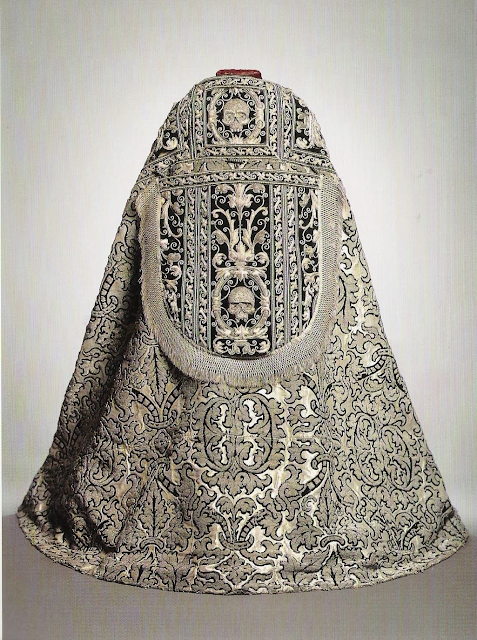Seeing the painting of the Madrid painter, José Moreno Carbonero, which is entitled "The Conversion of the Duke of Gandía" something seemed awfully familiar to me. The painting was done in 1884 and is found in the Museum of Prado who describe the scene as follows:
Seeing the cadaver of Empress Isabel of Portugal, the wife of Carlos V, has a profound effect on Francisco de Borja, Duke of Gandía, who almost collapses in front of one of his knights. The melodramatic vision with which the painter approaches this work is reinforced by the expressions of the other characters, such as the horrified boy, who may be seeing his first dead person, or the heartbroken lady who covers her face with her hands. The whiteness of the casket, shroud and catafalque capture the light entering from the left, leaving the back of the room in darkness. With this technique, the painter fully achieves the intensity and drama he sought. The perfect mastery of drawing and the tactile reproduction of the qualities of the different surfaces are the most outstanding elements in this artist´s work. His use of loose, paint-laden brushstrokes recalls the best of Spanish Baroque painting.But what my attention was drawn to was the cope of the officiating priest with its memento mori designs. Why was it so familiar? Well, as it turns out, it is actually a painted depiction of a cope that forms a part of a solemn Mass set we have featured here before, a sixteenth century Requiem set from the Royal Monastery of San Lorenzo in Madrid.
Here is a closer look at the cope in question that we see in the painting:
Of course, it is the front of the cope that we are seeing in the ptaining, and it is precisely the comparison of the orphrey designs that reveals the match:
I highlight this in part because it is the month of the holy souls, so it is a good opportunity to feature again a spectacular requiem set with memento mori, but also for the reason that I, personally, always find it enjoyable when we can match a historical set depicted in art with the actual, tangible vestments. It helps to emphasize the fact that these are not merely fantastical images coming out of the imagination of the painter, but rather concrete, historical, liturgical objects. Of course, in this particular instance as well, we also gain the benefit of seeing this vestment employed within its proper liturgical context and for its actual liturgical purpose.
-------
Do you like Liturgical Arts Journal's original content? You can help support LAJ in its mission and vision to promote beauty in Catholic worship either by:
You choose the amount! Your support makes all the difference.


















